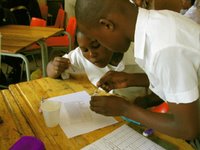
Practical experiences are an essential part of learning science. However, in many countries these experiences are not provided in the majority of their primary and secondary schools. There are several reasons for this: cost, safety, waste disposal and teacher preparation. Indeed, relatively few university students can be trained in science because of these factors. To help overcome these problems, microchemistry and other microscience kits and workbooks have been developed under this UNESCO project.
The project has been in existence for several years, and more than 80 countries have introduced microchemistry workshops and training courses. In some countries, UNESCO-Associated Centers have been established to further develop the microscience project. Now, English versions of the available microscience materials provide coverage of all educational levels: from primary to all of the secondary level (and university/tertiary level in some cases). While the set of teaching and learning packages is only complete in English, many specific microscience materials are available in other languages.
Download Microscience Materials (English Version): Click on the materials to download the different chapters.
I. Primary Microscience Experiences
II. Chemistry
III. Physics (Microelectricity)
IV. Biology
Bob Maybury, who is very active in the International Organization for Chemistry for Development (IOCD), asked me to post this comment for him:
ReplyDeleteI will write a short explanation of IOCD's involvement with this Microscience Project and hope you can put any or all of this on your blog for the benefit of your readers.
The Global Microscience Project supported by UNESCO is of great interest to IOCD, for in fact, we are associated with UNESCO, IUPAC, Radmaste in South Africa, and the International Foundation for Science Education, also in South Africa, in promoting this innovative project in many countries.
It was all started by Dr. John Bradley, an English chemist who moved to South Africa many years ago and became a Professor of Chemistry at the University of the Witwatersrand. He soon took an interest in bringing laboratory experiences in chemistry to the schools of South Africa, particularly to the black students, who in the period of Apartheid had little opportunity to go to school, let alone get hands-on laboratory experience in chemistry. He developed chemistry kits that featured very small amounts of chemicals and tiny laboratory equipment, naming it microchemistry experiments. He set up a small plant to manufacture these kits and eventually established a learning center at his university to prepare written experiments and teachers guides to accompany the kits (the organization called Radmaste). As time went on, this enabled actual laboratory chemistry to reach the majority of schools and students in South Africa and Bradley was honored by the State for his innovative leadership.
Several years ago, UNESCO's Division of Basic and Engineering Science embraced Bradley's program in microscience and are now using extra budgetary funds to spread it throughout the world. One of our IOCD scientists, Alexandre Pokrovsky, on retirement from this Division in UNESCO, about 3 years ago joined Bradley as his associate in the Foundation for Science Education, which Bradley also formed to promote microscience. Pokrovsky is active both in finding additional funds from major funding agencies to finance the expansion of microscience and also travels with Bradley to hold workshops with educators in countries where a ministry of education or a university decides to introduce microscience.
Pokrovsky stops by here in Washington from time to time and spends a day or two discussing the Global Microscience Project with me and bringing me up to date on its status. Recently he told me it is now being used in 35 different countries.
The course materials (written text of the textbook and teachers guide and blueprints of the apparatus) can be downloaded free of charge by any student. teacher, or school system or university from the UNESCO website. Once on the UNESCO website, one only needs to click "Science" then "Basic Sciences" and on this click "The Global Microscience Project" to be able to download the material.
The strategy Dr. Bradley has adopted for spreading this project throughout the world is to reach an agreement with a minister of education or a university that enables this party to obtain blue prints (free of charge) of all the equipment that has been developed at Radmaste and the associated factory in South Africa. Bradley and Pokrovsky then also work with this minister or university negotiating with various funding sources (such as the Arab Development Bank, etc.) to obtain the funds needed to implement the project (construct the apparatus, purchase the chemicals and other supplies, print the written material, etc. ).
.
IOCD's part has always been very modest, mostly putting our name and logo on the agreements negotiated by Pokrovsky, of in several cases, having our President, Dr. Jean-Marie Lehn, a French Nobel Laureate, write an introductory piece to the course manual emphasizing the importance of hands-on laboratory experience to a student's learning of science. I have also placed an announcement of the availability of the Microchemistry course on the IOCD website at www.iocd.org
Cordially,
Bob Maybury